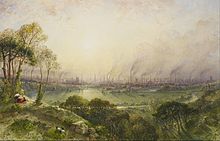20:
124:
between the 18th century and 19th centuries and were known to foul the airs in most larger cities but were most noted in large industrial centers like
Manchester England or Pittsburgh Pennsylvania. During the dramatic growth and evolution of systems used to produce electricity coal burning central
111:
and pollutants from ground level releases during ever larger industrial activities. The difference in temperature between the bottom inside and outside of the stack helped to increase the rate air flow through the furnace known as the stack effect.
137:
issue. During the 20th century fans were used to increase air currents needed in furnaces while heights that reached 1,300 feet grew as a way to comply with environmental safety regulations passed by governments.
19:
99:
in furnaces with the goal of producing steam to drive generators for electricity, for the smelting ores, or as a separation or
103:
process. The carefully constructed circular stacks were used to both increase the flow of combustible air but also isolate
147:
178:
197:
36:
165:
121:
8:
134:
75:
52:
85:
80:
126:
108:
56:
40:
191:
24:
104:
96:
70:
51:
fired electric stations in urban areas were common prior to the use of
66:
44:
100:
92:
129:
were found throughout cities that released noxious fumes and
39:. The factories stereotypically used in such industries have
133:
into the city air. Taller smokestacks helped to reduce this
130:
48:
148:
European Union: Global sources of air pollution by country
47:. During the earliest era of electric power development,
23:
Smokestacks in
Manchester England c. 1858 watercolor by
189:
59:electricity could only travel short distances.
43:, hence the name, and produce a high volume of
95:used in the process of combusting mostly
18:
190:
120:Smokestacks were first used during
16:Pollution-generating basic industry
13:
14:
209:
141:
125:electric stations that relied on
91:Smokestacks are large industrial
172:
159:
35:is a basic, usually cyclical,
1:
153:
62:Example industries include:
7:
10:
214:
115:
37:manufacturing industry
28:
122:Industrial Revolution
22:
76:Automotive industry
53:Alternating current
33:smokestack industry
29:
86:Electric industry
81:Chemical industry
205:
183:
176:
170:
163:
55:for lighting as
213:
212:
208:
207:
206:
204:
203:
202:
188:
187:
186:
177:
173:
164:
160:
156:
144:
118:
41:flue gas stacks
17:
12:
11:
5:
211:
201:
200:
185:
184:
171:
167:Investor Words
157:
155:
152:
151:
150:
143:
142:External links
140:
127:direct current
117:
114:
109:carbon dioxide
89:
88:
83:
78:
73:
57:Direct current
15:
9:
6:
4:
3:
2:
210:
199:
198:Manufacturing
196:
195:
193:
182:
181:
180:Using English
175:
169:
168:
162:
158:
149:
146:
145:
139:
136:
135:environmental
132:
128:
123:
113:
110:
106:
105:exhaust gases
102:
98:
94:
87:
84:
82:
79:
77:
74:
72:
68:
65:
64:
63:
60:
58:
54:
50:
46:
42:
38:
34:
26:
21:
179:
174:
166:
161:
119:
97:fossil fuels
90:
61:
32:
30:
25:William Wyld
154:References
71:steelworks
45:pollution
192:Category
101:refinery
93:chimneys
116:History
131:soot
69:and
67:Iron
49:coal
194::
107:,
31:A
27:.
Text is available under the Creative Commons Attribution-ShareAlike License. Additional terms may apply.
